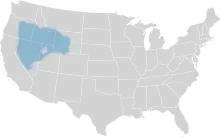Snake Indians
Snake Indians is a collective name given to the Northern Paiute, Bannock, and Shoshone Native American tribes.


The term was used as early as 1739 by French trader and explorer Pierre Gaultier de Varennes, Sieur de la Verendrye when he described hearing of the Gens du Serpent ("Snake people") from the Mandans. This is probably the first written mention of the Shoshone people. The term "Snakes" is also used to refer the Shoshone by British explorers David Thompson and Anthony Henday.[1]
This term was widely used by American immigrants on the Oregon Trail in the Snake River and Owyhee River valleys of southern Idaho and Eastern Oregon.[2][3] The term "Snake Indian" later included the Northern Paiute tribes found in the basins between the Cascade Mountains and these valleys in Oregon and northern Nevada and northeastern California. These people were the opponents of the California, Oregon and Washington Volunteers and U.S. Army, in the Snake War.
In Canadian history
From 1688-1720s, when the British Empire first came into prolonged trade contact with the Western Cree and Blackfoot, both of these groups were united in war against "the Snake Indians" of Canada.[4] It is not clear if this term (used in this period of Canadian history) is meant to refer to Northern Paiute people, or if it is inaccurate, or perhaps entirely unrelated.
Notes
- "Archived copy". Archived from the original on 2013-06-20. Retrieved 2013-06-09.CS1 maint: archived copy as title (link)
- Bancroft, Hubert Howe. History of Oregon, Volume II, 1848-1888. The History Company, San Francisco, 1888, p.462 note 4.
- "Wyoming History - Shoshoni and the Seeds of Change". Wwcc.cc.wy.us. Archived from the original on 2012-06-27. Retrieved 2013-03-26.
- http://www.mhs.mb.ca/docs/mb_history/20/plainscree.shtml